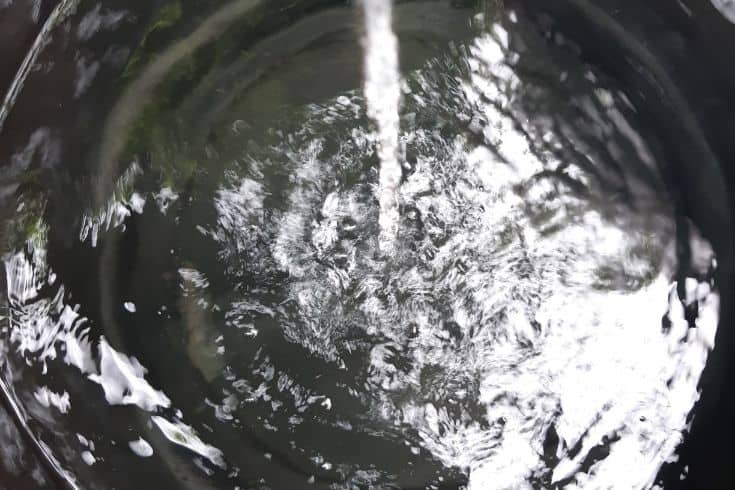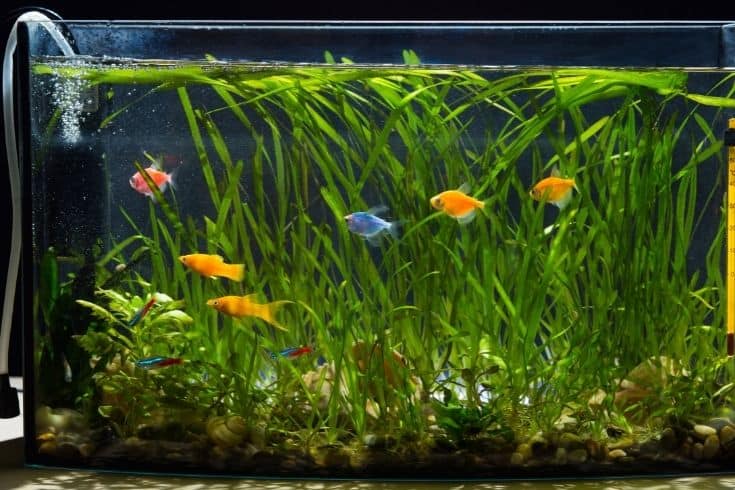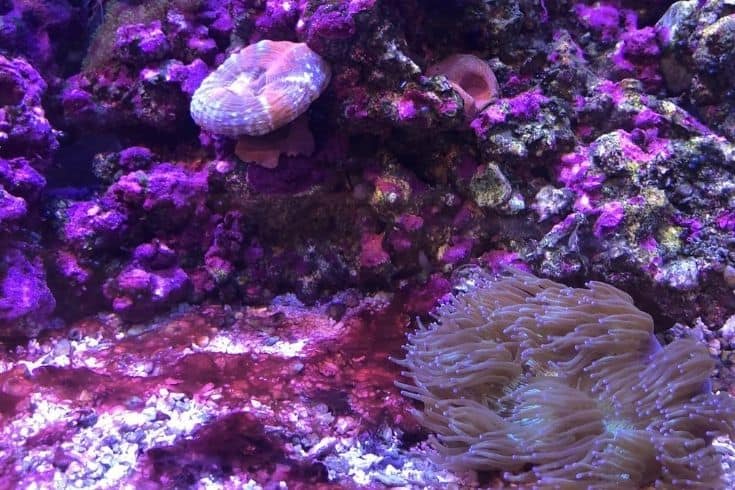Every reef aquarist wants to keep their aquarium beautiful and thriving. Unfortunately, one problem that can plague reef tanks is red slime algae (cyanobacteria). Red slime algae are not only unsightly, but it can also be harmful to your fish and other marine life. This type of algae produces toxins that can poison your fish and other marine life.
If you’re dealing with red slime algae in your reef tank, don’t despair. The aquarium community is full of reefers who have been there and done that. In this article, we’ve compiled some of the best tips from experienced reefers on how to get rid of red slime algae.
What Is Red Slime Algae?
Before we get into how to remove red slime algae, it’s important to clarify that this phenomenon is actually caused by cyanobacteria. So, while “red slime algae” is the most common name for this problem in reef tanks, it’s not technically accurate. The microscopic organisms that cause this problem are actually bacteria, not algae.
Cyanobacteria also come in a variety of colors, including red, green, blue, brown, and black. It is common in marine aquariums, though it can be found in both saltwater and freshwater tanks. Cyanobacteria are one of the oldest groups of bacteria on earth and are thought to be responsible for helping to create the oxygen-rich atmosphere that we enjoy today.
While cyanobacteria are generally considered to be helpful, in reef aquariums they can quickly become a nuisance. When conditions are right, cyanobacteria can reproduce very quickly, and they can quickly take over an aquarium. When this happens, they can crowd out other marine life, and produce toxins that can harm fish and other creatures.
Causes of Red Slime Algae
There are a number of factors that can contribute to the bloom of cyanobacteria in aquariums. We’ll cover some of the most common causes here.
Excess Nutrients
Explosive cyanobacteria growth can often be attributed to an excess of nutrients in the water. When there are high levels of phosphate and nitrogen in the water, it can create the perfect conditions for cyanobacteria to bloom.
In reef aquariums, this is often caused by overfeeding. If too much food is added to a tank, any uneaten food can build up, break down, and fill the entire aquarium with nutrients. This problem is also often exacerbated by a lack of maintenance – if an aquarium is not cleaned frequently enough, these excess nutrients won’t be removed at an appropriate rate, leading to an outbreak of cyanobacteria.
It’s also important to be aware that substances used to promote coral growth (such as two-part solutions and water additives) can also contribute to the problem of excess nutrients. Though these substances may be great for those who want beautiful coral, they need to be used correctly. Otherwise, they can add too many nutrients to the water, and cause an outbreak of cyanobacteria.
Intense Lighting
Cyanobacteria is a photosynthetic organism, which means that it needs light to grow. If an aquarium is lit for too long, or if the light is too intense, it can create the perfect conditions for cyanobacteria to bloom.
This problem is often seen in new tanks, or in cases where aquarium hobbyists have recently changed their lighting. It can also be caused by an increase in the intensity of existing lighting, such as when a new bulb is installed.
Although aquarium plants also need light to grow, they generally don’t bloom under the same intense light conditions that cyanobacteria need. So, if you find that your aquarium is being overrun by cyanobacteria, one solution may be to reduce the amount of light that your aquarium receives.
Hypersalinity

Though unusual, cyano growth can sometimes be caused by hypersalinity – that is, water that is too salty. In a saltwater aquarium, hypersaline water is often caused by evaporation. When the water in an aquarium evaporates, it leaves behind salt, which can raise the overall salinity of the water.
If you find that your aquarium has high salinity levels, you can use a hydrometer to test the water. If the reading is above 1.025, then the water is hypersaline, and this may be causing an outbreak of cyanobacteria.
The solution to this problem is simple – just add fresh water to the tank to lower the salinity levels. You may also need to do a partial water change to remove some of the salt from the water.
Getting Rid Of Cyanobacteria: Top Tips
Now that we’ve covered some of the main causes of cyanobacteria, let’s take a look at some tips on how to get rid of it.
Note: these tips are meant to address an outbreak of cyanobacteria. If you want to prevent an outbreak from happening in the first place, be sure to refer to the previous section for tips!
1. Check If You Have Too Much Lighting

As we’ve previously mentioned, the aggressive growth of cyanobacteria is often caused by too much light. If you find that your aquarium is being overrun by cyanobacteria, one solution may be to dial back on the intensity of your aquarium lights. LED lights are especially good for this as they can be dimmed to prevent future blooms.
You can also try turning off your lights for a few days. This will give the cyanobacteria a chance to die off, though you need to be careful that your plants don’t start to suffer from a lack of light. Remember that glucose is a byproduct of photosynthesis – one that your plants need to survive.
2. Maintain Your Tank Well
A lack of water changes wreaks havoc in all aquariums but is especially troublesome in reef tanks where coral need stable water parameters. If you don’t keep up with your regular water changes, your aquarium inhabitants will start to feel the effects – an outbreak of cyanobacteria and excess algae growth are just some examples.
Cyano growth is often caused by an accumulation of excess nutrients in the water. If you don’t do regular water changes, these nutrients will build up over time, and wreak havoc on your tank.
If you’re already dealing with an outbreak of cyanobacteria, doing a partial water change is one of the best ways to get rid of it. This will help to remove some of the excess nutrients from the water and make it harder for the cyanobacteria to grow.
3. Introduce A Protein Skimmer
Everyone knows that aquariums need filtration, but not everyone realizes the importance of protein skimmers. Protein skimmers are one of the best ways to maintain a beautiful aquarium, particularly if you frequently deal with issues relating to leftover food.
Food sources are one of the main ways that nutrients enter an aquarium. If you have a lot of uneaten food in your tank, it will start to decompose, and release these nutrients into the water. A protein skimmer will help to remove these leftover food particles before they have a chance to do so.
Lower-quality foods are especially notorious for causing problems in an aquarium. If you find that you’re constantly dealing with cyanobacteria or algae blooms, it may be time to switch to high-quality foods such as Hikari or New Life Spectrum. These foods are less likely to cause problems in your aquarium and will help to keep your tank clean and clear.
4. Consider A Phosphate Reactor
As we’ve mentioned, one of the main causes of cyanobacteria is an accumulation of excess nutrients in the water. Phosphates are one of the main nutrients that cyanobacteria need to grow, so it’s important to keep them under control.
The best way to do this is to use a phosphate reactor. A phosphate reactor is a chamber that contains media that helps to remove phosphates from the water. The water is then passed through this chamber, and the concentrations of phosphate are greatly reduced.
This is an especially effective method of lowering the levels of phosphates in a tank and can help to prevent future cyanobacteria blooms.
5. Use A Reliable Water Source
Frequent water changes may go a long way in preventing cyanobacteria blooms, but you’ll find that they’re much less effective if you’re using water that contains high levels of nutrients.

This is why it’s important to use a reliable water source. If you’re using fresh tap water, be sure to treat it with a quality dechlorinator such as Seachem Prime. This will remove the chlorine from the water, and make it safe for your aquarium inhabitants.
You can also opt for RO/DI water. This is water that has been filtered to remove impurities and is ideal for use in aquariums. Above all, clean water is essential for preventing cyanobacteria blooms.
6. Increase Water Movement
Cyanobacteria tend to grow best in stagnant water, so it’s important to make sure that your tank has adequate water movement.
Aquarium pumps are a great way to increase water flow and can help to keep your tank clean and free of cyanobacteria. Pumps can also maintain a healthy oxygen level in the water, which is essential for your fish and other aquarium inhabitants.
You can also use powerheads as a means of increasing water movement. Powerheads are small, submersible pumps that can be placed in strategic locations around the tank – particularly in areas where there is inadequate water flow.
7. Introduce Live Plants
Live plants are a great way to add beauty to your aquarium, and can also help to keep it clean and free of cyanobacteria.

Plants are natural filters and help to remove excess nutrients from the water. This makes it harder for cyanobacteria to grow by removing one of their main food sources. In addition, plants help to increase water movement and oxygenation. This is essential for maintaining a healthy aquarium environment.
There are many different types of live plants that you can choose from, so be sure to do some research to find the best ones for your tank!
8. Acclimatize or Cure Live Rock Properly
If you’re setting up a new aquarium, it’s important to make sure that your live rock is properly acclimatized or cured.
Curing live rock is a process of allowing it to sit in the aquarium for a period of time (usually around 2 weeks) so that it can release any harmful toxins that it may contain. Acclimatization, on the other hand, is the process of slowly introducing the live rock to the aquarium over a period of time (usually around 2 hours).
Either way, it’s important that you do this properly so that your live rock doesn’t release any toxins into the water that could cause cyano growth or worse still, cause harm to your fish or other aquarium inhabitants.
9. Chemical Treatments
Chemical treatments such as Chemi-Clean, Blue Life Red Cyano RX and Ultralife Red Slime Stain Remover can be used to remove cyanobacteria from your aquarium. However, we recommend thinking of these options as a last resort for immense cyanobacteria blooms that haven’t been controlled by any other means.
These treatments work by killing the active cyano bloom, but they can also kill other beneficial bacteria in your tank. This can cause a mini cycle in your tank, in which ammonia and nitrite levels spike. This is why we recommend using these treatments only as a last resort, and always following the manufacturer’s instructions to the end should be avoided if possible.
We also recommend that you remove any carbon from your filter when using these treatments, as carbon will remove the chemicals from the water before they have a chance to work.
10. Bacterial Treatments
Another alternative to chemical treatments is to use a bacterial treatment. Korallen-Zucht Cyano-Clean and Dr. Tim’s Cyanobacteria Treatment are two examples of products that can be used to treat cyanobacteria.
These treatments work by introducing beneficial bacteria into the water, which helps to break down the cyanobacteria and prevent them from growing. These treatments are much safer than chemical treatments and can be used on a more regular basis without harming your tank.
However, it’s important to note that these treatments will not work immediately, and it may take a few weeks for the beneficial bacteria to establish themselves in the aquarium and start breaking down the cyanobacteria.
11. Physical Removal

Physical removal is another option for dealing with cyanobacteria and is often the most effective method.
The best way to remove cyanobacteria is to simply suck it out of the water with a turkey baster or some other type of syringe. You can also use a toothbrush or other type of brush to scrub it off of rocks and other surfaces in the aquarium.
Once you’ve removed as much of the cyanobacteria as possible, be sure to perform a water change to remove any toxins that may have been released into the water.
Prevention is the Best Cure
As they say, prevention is the best cure, and this is certainly true when it comes to cyanobacteria. The best way to prevent cyanobacteria is to take steps to promote a healthy aquarium environment. This means regular water changes, maintaining proper water parameters, and avoiding overfeeding. It also means making sure that your live rock is properly acclimatized or cured.
By taking these steps, you can help to ensure that your aquarium is less likely to experience a cyanobacteria bloom and that any blooms that do occur can be more easily controlled.
We hope you found this article helpful. If you have any questions or comments, please feel free to post them below. Thanks for reading!
